Marco Silva’s Fulham has become a team known for its tactical discipline and flexibility, making them a tough opponent in the Premier League. Known for his attacking philosophy, Silva has implemented a system that emphasizes fluidity, high pressing, and intelligent movement both on and off the ball. Fulham’s structure under Silva is built around a balance between defensive resilience and quick transitions, allowing them to adapt to various opponents while maintaining their identity. This tactical analysis dives into the key elements of Silva’s strategy, shedding light on how he has shaped Fulham’s style of play and its impact on their performances.
Build-up
Marco Silva sets his team up in a 1-4-3-3 formation in the build-up, with a back four, one number-six, two number-eights, and a front three.
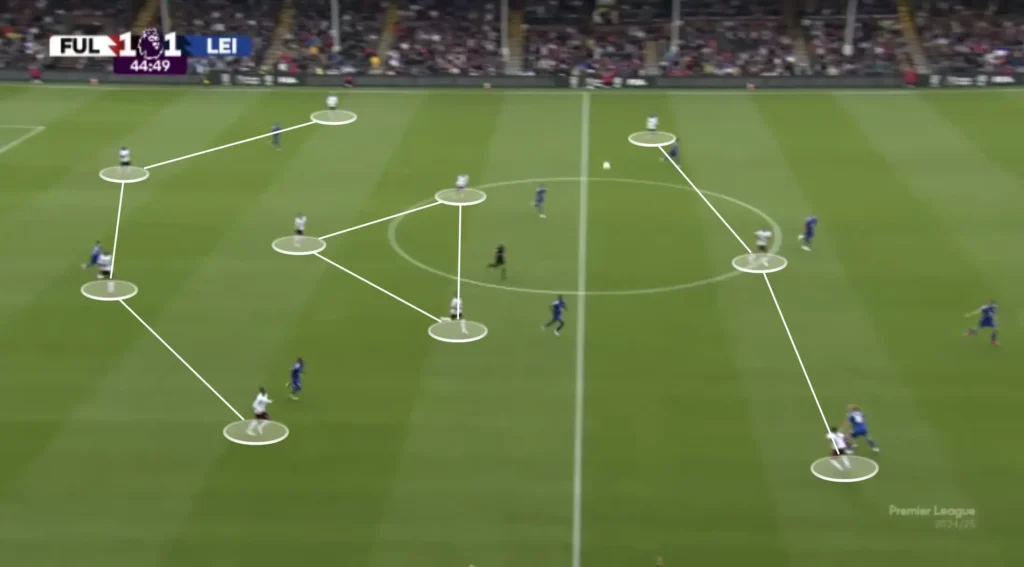
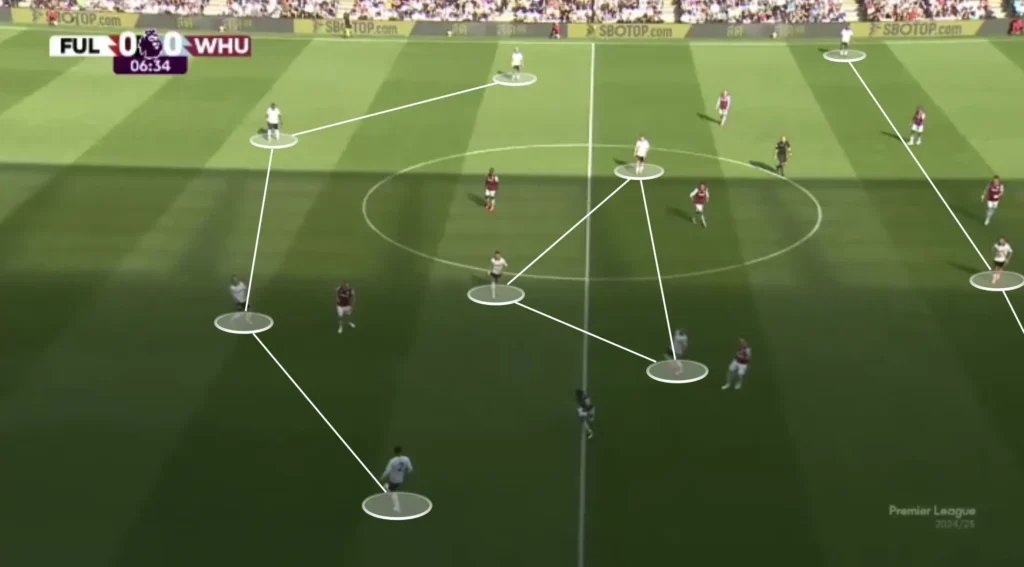
Building up in a 1-4-3-3 formation focuses on creating a solid foundation at the back while maintaining fluidity and options in the midfield. The formation begins with four defenders, who provide width and stability, allowing for controlled possession from deep areas. The single defensive midfielder connects the defense to the midfield, dictating the tempo and distributing the ball to the two more advanced central midfielders. These midfielders position themselves to exploit spaces between the opposition’s lines, creating passing triangles that facilitate smooth progression up the pitch. The three forwards, with the central striker as the focal point, are always ready to receive the ball, either through direct passes or by making runs behind the defense. This setup allows the team to transition quickly from attack to defense, maintaining pressure on the opponent while ensuring defensive coverage.
Rotations
The Fulham players constantly rotate during the build-up. The team adopts a dynamic approach, shifting between formations to create numerical advantages and exploit spaces. Marco Silva’s focus is always to get the players into their best positions, where they can make the most out of their individual skills. He emphasizes versatility, with players interchanging positions seamlessly to maintain possession and disrupt the opposition’s defensive structure. This flexibility creates numerical superiorities in different areas, allowing Fulham to bypass the opposition’s press while maintaining control. The movement is coordinated and dynamic, with constant interchanging between lines, making it difficult for opponents to predict or disrupt Fulham’s build-up play.
Teamwork Between Wide Players
Fulham’s tactical setup under Marco Silva relies heavily on the fluid teamwork between the fullback, winger, and number-eight. This trio works in harmony to create overloads, dominate the wide areas, and generate attacking opportunities.
On the left side, the left-back, Antonee Robinson, usually pushes up into a left-wing position, the left-winger, Alex Iwobi, comes into an attacking midfield position, and the number-eight, Emile Smith-Rowe, drops down into a left-back/left holding midfielder position.
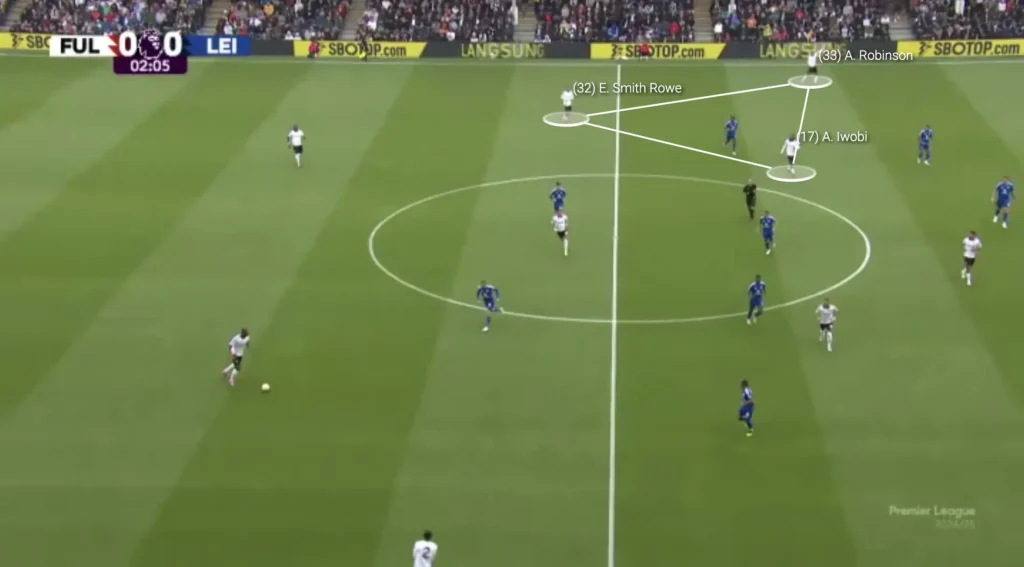
On the right side, Kenny Tete stays in the right-back position, Andreas Pereira pushes up into an attacking midfield position, and Adama Traoré stays as a right-winger.
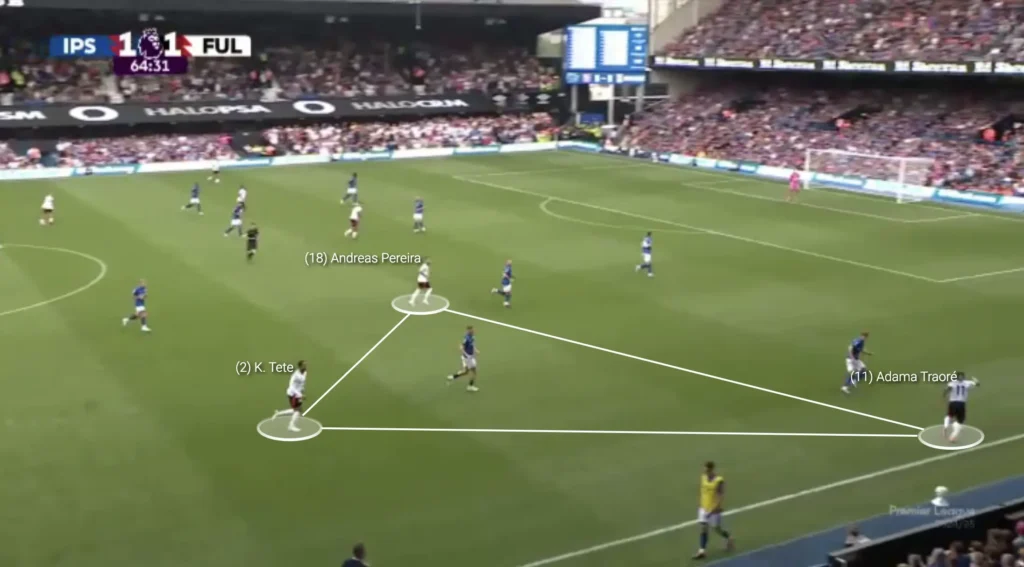
The three players on each side always rotate and interchange to confuse and create questions for the opposition. This fluid movement allows for greater unpredictability in the attack, as the wide player often comes inside, dragging defenders with them, while the fullback overlaps into the vacated space. Simultaneously, the attacking midfielder can drop deeper or drift wide to link play or exploit gaps in the defense.
Here, Antonee Robinson makes a run out to the wing from the attacking midfield position, opening the space in the center. Smith-Rowe, who is in a deeper position, makes a run into the opened space and receives a pass from the winger, allowing him to take the ball forward and attack the defense.
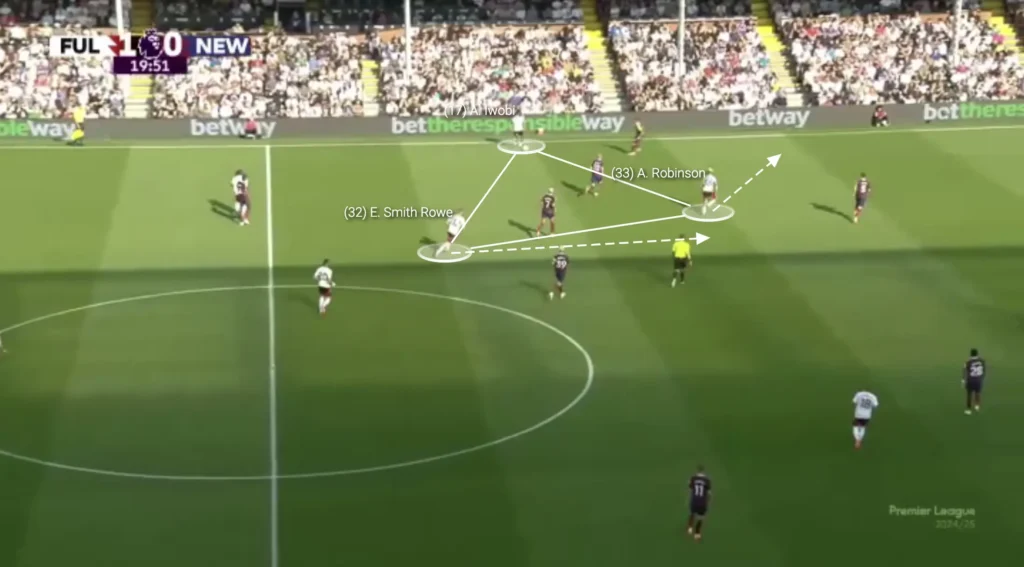
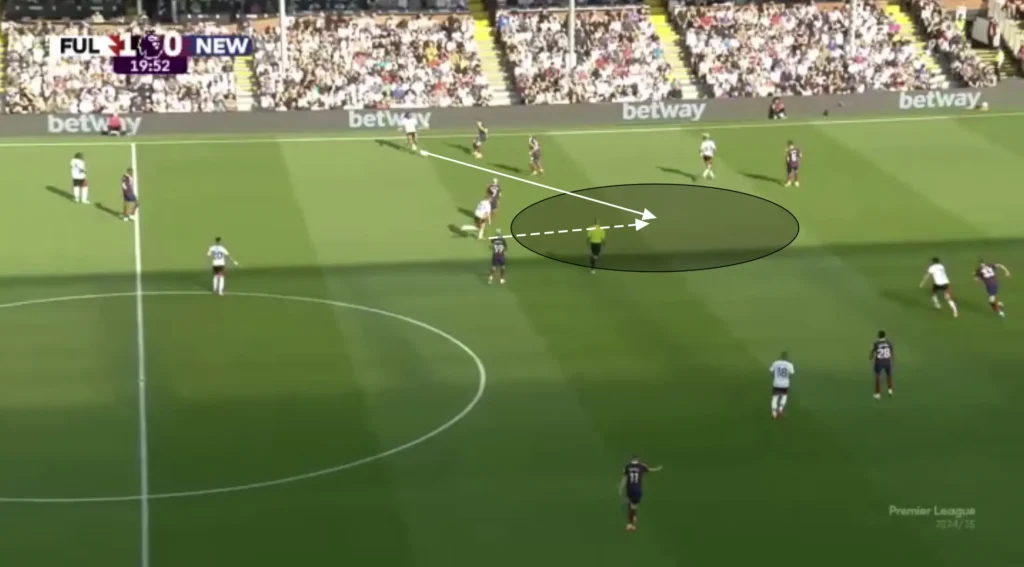
These positional interchanges create overloads on the flanks while opening up central spaces, making Fulham’s attacks more versatile and harder to defend against.
Using the Goalkeeper
Marco Silva likes using the goalkeeper in the build-up. Fulham’s goalkeeper, Leno, will often push up between the center-backs, giving Fulham an extra man in the build-up phase.
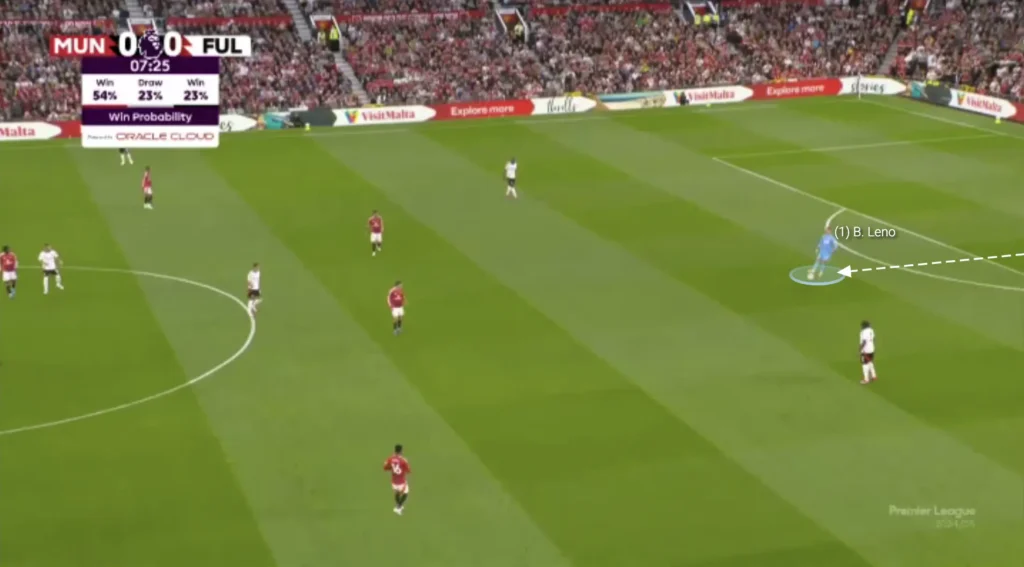
Using the goalkeeper in the build-up phase offers numerous tactical advantages. By involving the goalkeeper, Fulham can create numerical superiority at the back, making it easier to evade the opponent’s press and maintain possession. This additional player allows for more passing options, reducing the risk of losing possession and enabling smoother transitions from defense to attack. The goalkeeper can also act as a pivot, switching play across the field to exploit weak points in the opposition’s formation. Furthermore, involving the goalkeeper helps in drawing the opposition forward, creating space higher up the pitch for attackers to exploit.
Additionally, with the goalkeeper pushing up, the center-backs can come wider.
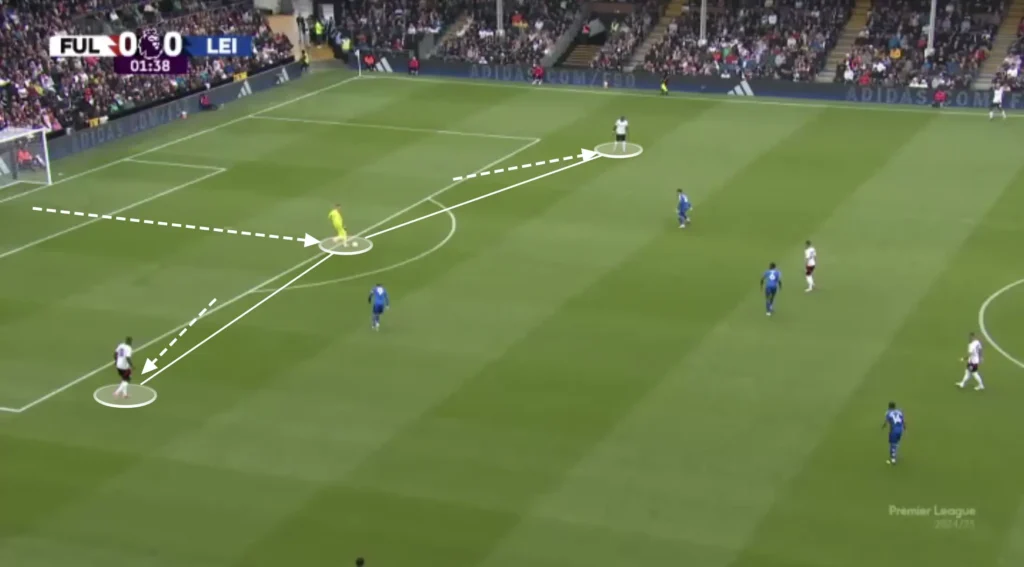
When the center-backs come wider, they can take the ball forward when receiving it to break the opposition’s first line of pressure. This provides a safe and easy way for Fulham to break the opposition’s first line and progress the ball up the pitch.
Counter-Movements
Fulham will often use counter-movements between the attackers to beat the opposition’s defensive line. Counter-movements involve players making runs that disrupt defensive lines, drawing defenders out of position to open up spaces for teammates. This is a core principle in Fulham’s attacking strategy, allowing them to break down organized defenses and exploit gaps.
When a defender or holding midfielder has the ball, the winger can drop to give a passing option to the ball-holder. This creates a question for the opposition fullback. If he follows the dropping winger, the space behind him opens up, allowing the ball-holder to play a through-ball to a Fulham attacker making a run in behind. However, if he stays in the backline to cover the space, the ball can be played to the winger, who can turn and attack the defense.
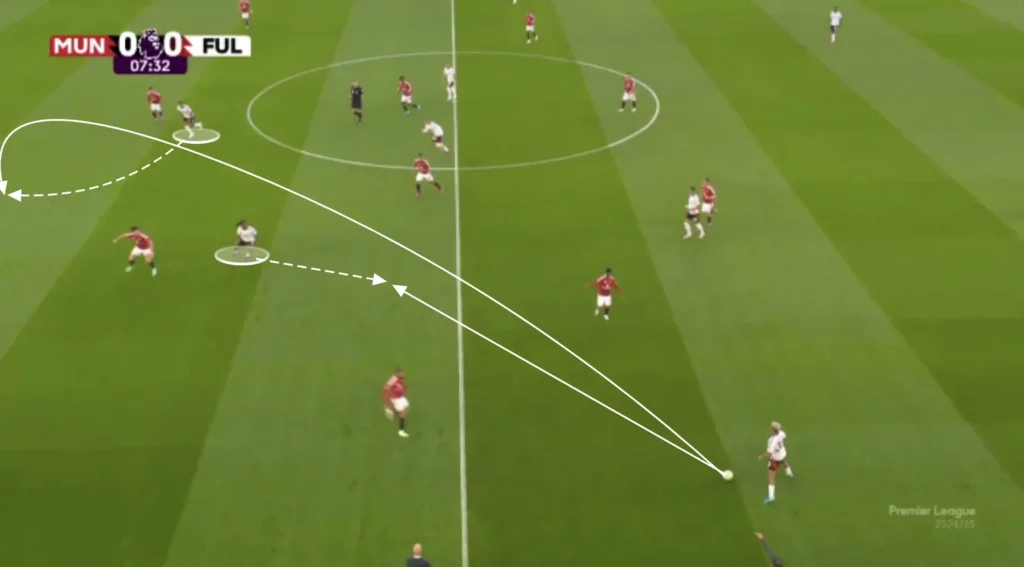
The Fulham attackers will use counter-movements like these all the time. When one attacker drops, the other will go in behind, constantly creating questions for the opposition defenders. In this situation, the opposition right-back follows the dropping winger, allowing Fulham to play a through-ball to the left-back in the space behind the right-back.
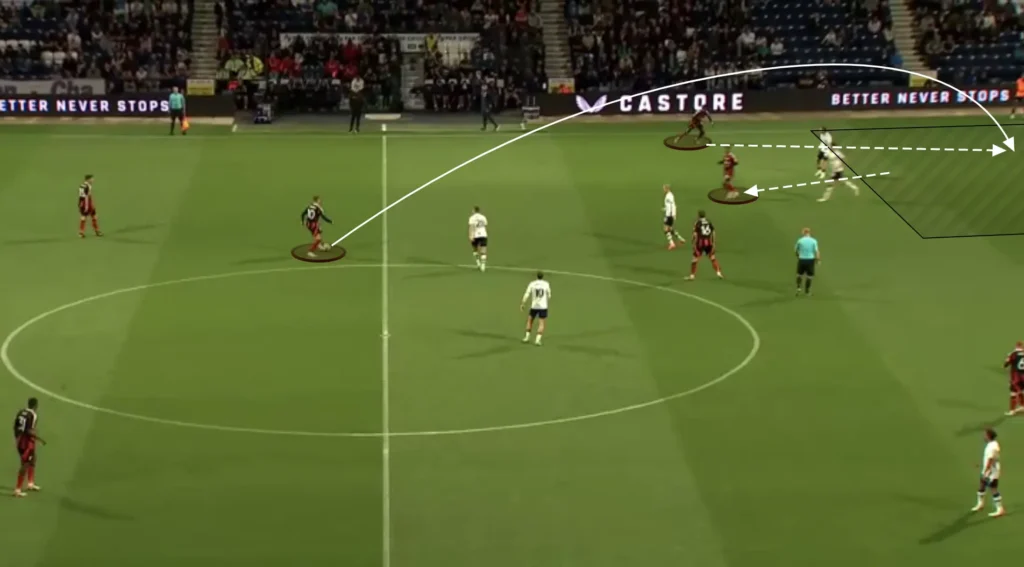
Overlaps
Fulham have effectively used overlaps as a key tactic to create goal-scoring opportunities under Marco Silva. This involves wide players, usually fullbacks, making forward runs to get around their winger, providing an extra attacking option on the flanks. By doing so, they create a 2v1 situation with the winger against the opposition fullback, which could be used to beat the fullback and create crossing opportunities.
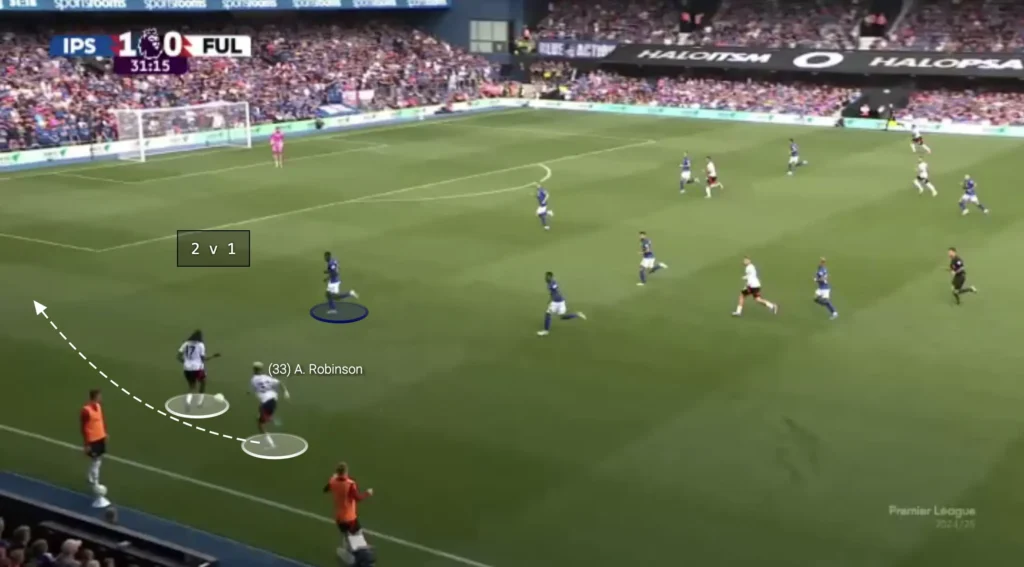
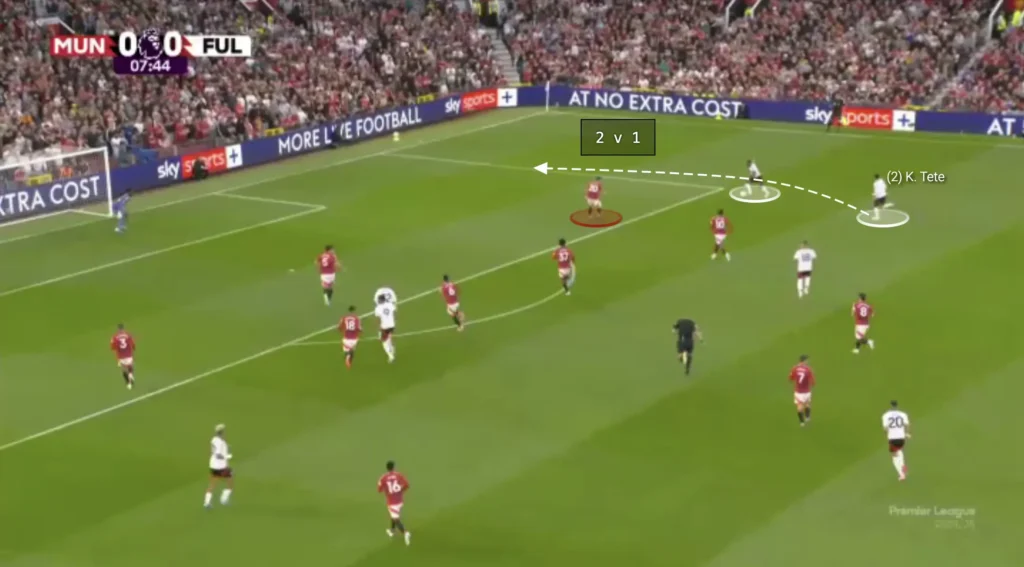
Fulham’s wingers often initiate the play by attracting the opposition fullback, leaving space for an overlapping Antonee Robinson or Kenny Tete to exploit. The overlap forces the defending fullback to make difficult decisions—either stick with the winger or follow the overlapping fullback. If the opposition fullback drops to cover the overlapping run, the winger could cut inside, taking a shot or combining with a midfielder. If the fullback covers the center, the ball can easily be played to the overlapping player, creating a crossing opportunity.
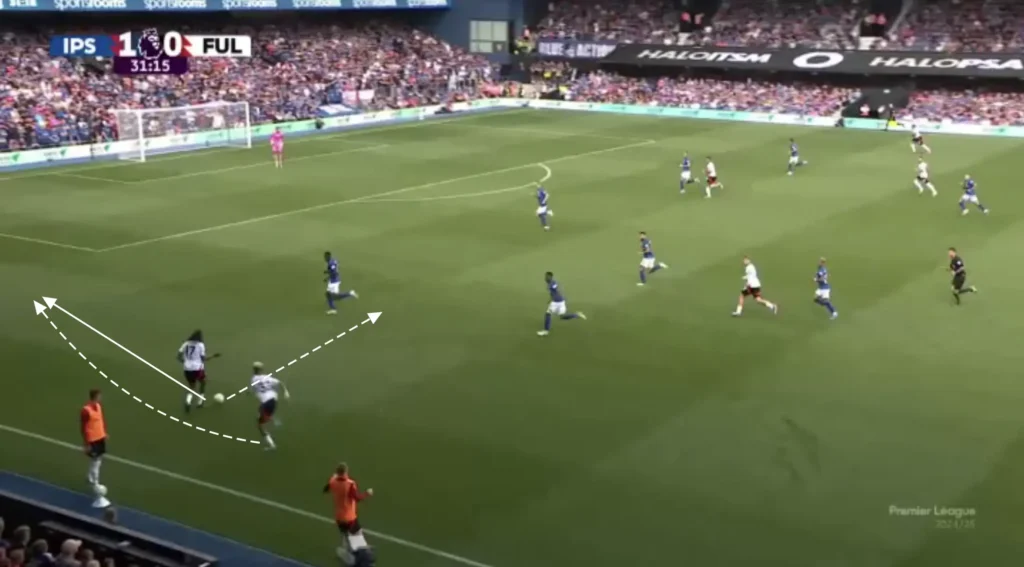
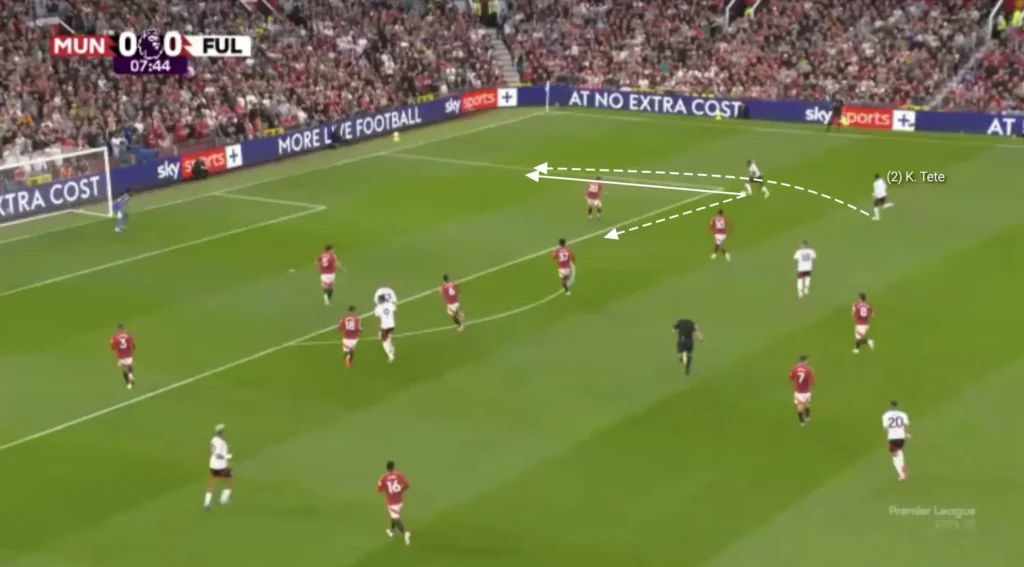
When executed well, this tactic allows Fulham to overload the wide areas, often pulling defenders out of position and creating space in the box. The fullback then has the option to deliver a cross or cut-back, aiming for the Fulham attackers in the box, who thrive on these deliveries. This use of overlaps not only creates width but also forces defensive mismatches, opening up clear chances for Fulham’s forwards and midfielders to finish. It’s a crucial element of Marco Silva’s attacking strategy, adding variety to Fulham’s offensive play and increasing their threat in the final third.
Underlaps
Fulham will also use underlaps to produce opportunities in the final third. They primarily do this from the wide areas with runs from the attacking midfielders into the space between the opposition fullback and center-back.
When the winger receives the ball out wide he will attract the opposition fullback. This opens the space between the fullback and the center-back, which allows Fulham’s attacking midfielder to make the underlapping run into this space. The ball can be played to the underlapping player, who can cross the ball into the box or attack his defender in a 1v1 situation.
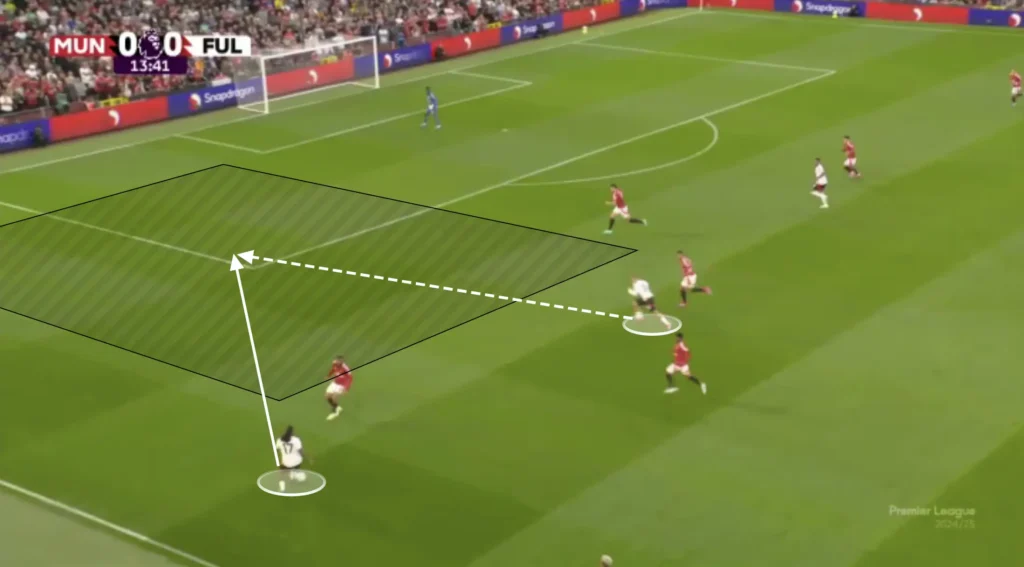
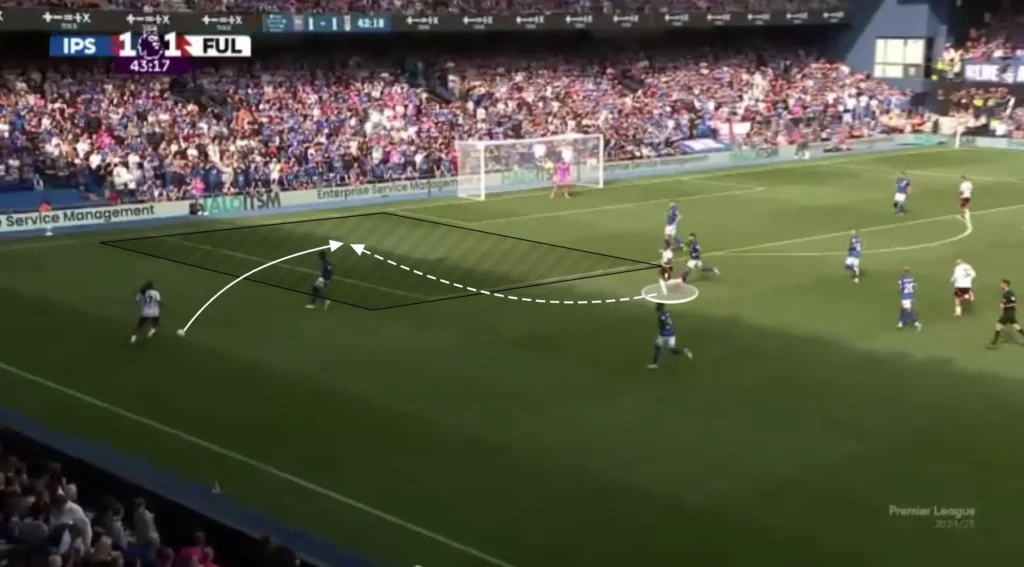
The winger does not have to play the ball to the underlapping player. The run from the attacking midfielder will often drag away an opposition defensive midfielder, which opens the space inside. The winger can take the ball inside and shoot or find a pass to a free player in front of the backline.
Defending
Fulham’s base formation when defending is the 1-4-4-2 formation. They look to set up in a mid-block, always trying to close the center and force the opposition out wide. Defending in the 1-4-4-2 formation is all about balance, compactness, and discipline. The team defends in two compact lines of four, with the forwards positioned ahead of the midfield. The two forwards play a crucial role, not only as the first line of defense but also in initiating the team’s pressing strategy. Silva wants his team to stay compact without dropping too low, preferably closing the space between the midfield and backline.
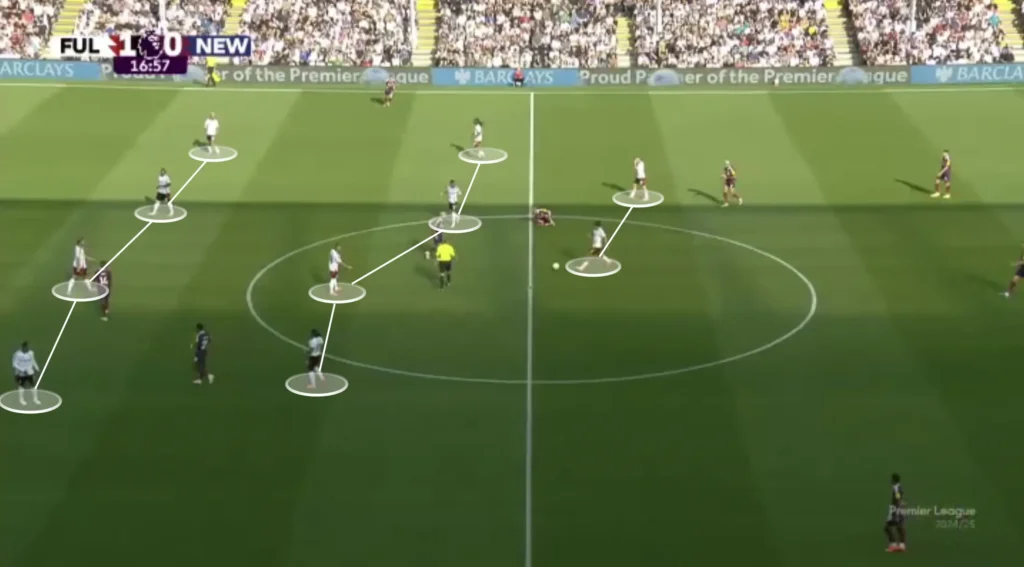
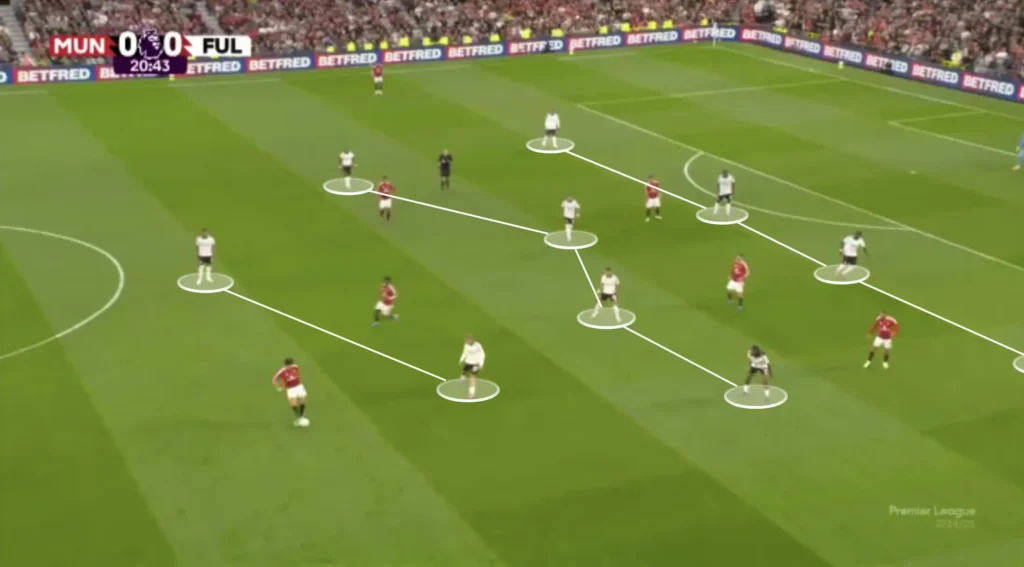
Higher up the pitch, Fulham will sometimes set up in a 1-4-2-4 formation, with the wingers pushing up next to the strikers.
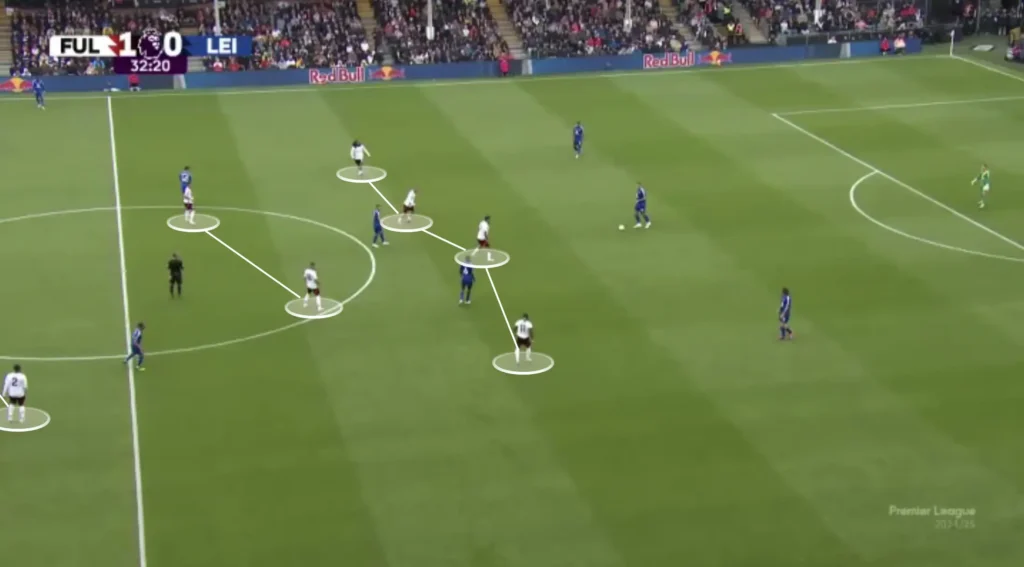
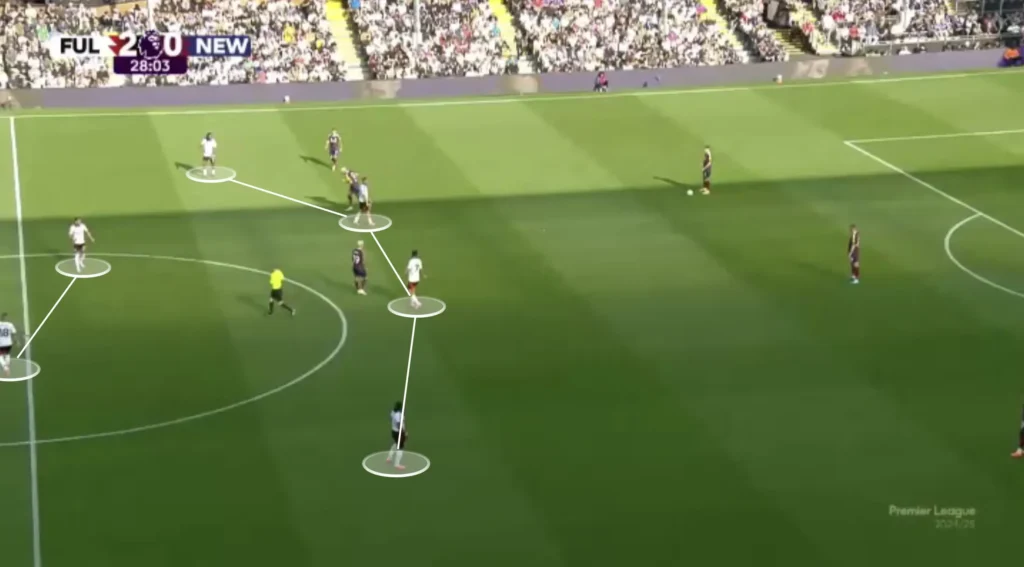
In Fulham’s 1-4-2-4 formation, the wingers will press the opposition center-backs while the two strikers cover the opposition’s holding midfielders.
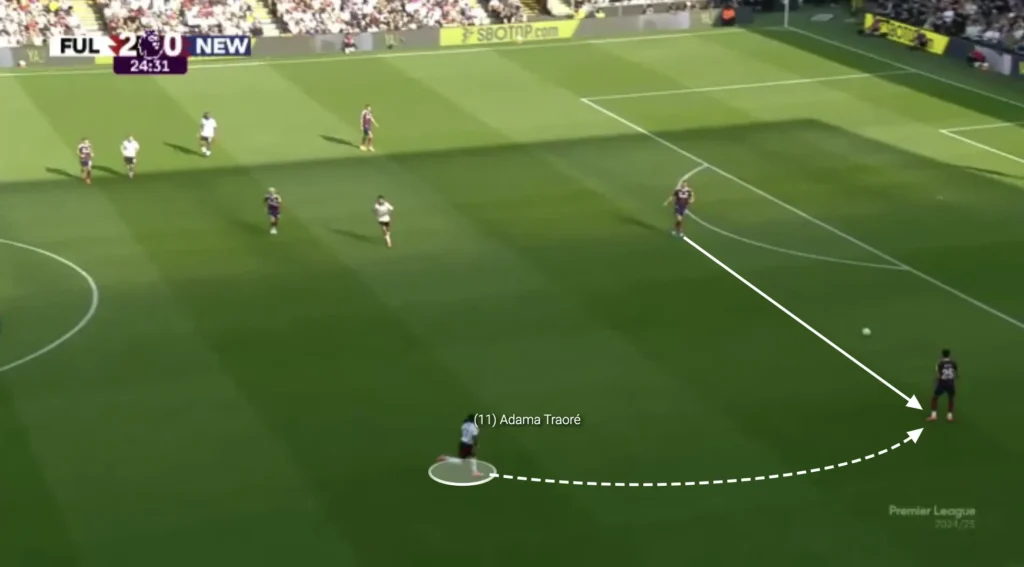
When the wingers press the center-backs, they close the passing lanes to the opposition fullbacks/wingbacks. This forces the opposition center-backs into the middle, where Silva wants to win the ball with the strikers, who block off all passes to the opposition midfielders.
High Backline (Def)
One tool that helps to be compact is to play with a high backline, making the space to the midfield line as small as possible. Silva’s players do this and usually try to keep the highest line they can without leaving the space behind them too open. Defending with a high backline involves positioning the defensive line closer to the midfield, rather than near the goalkeeper. This tactic compresses the space available for the opposing team to operate, disrupting their build-up play and increasing the chances of winning the ball back quickly.
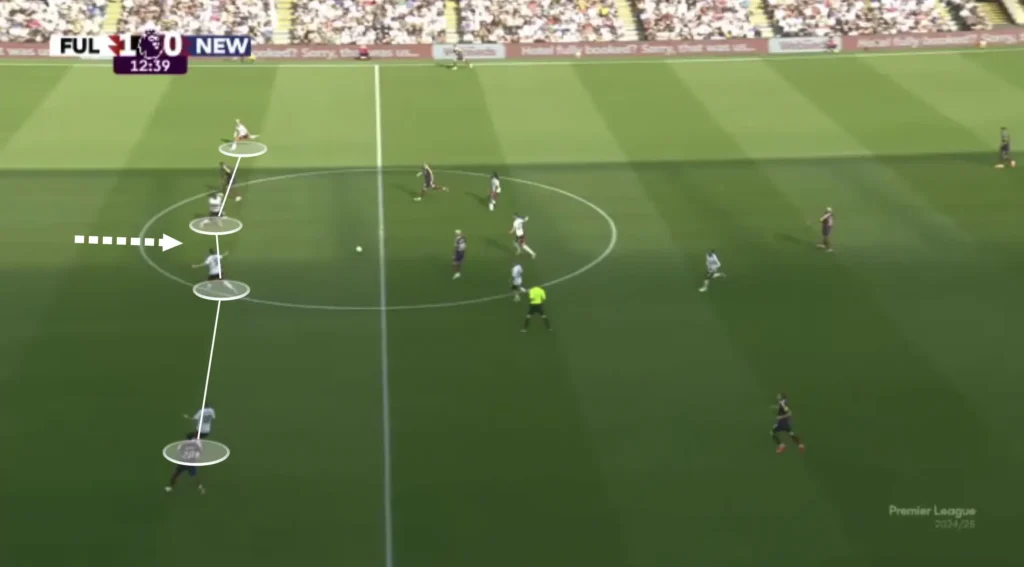
A high backline also allows defenders to support the midfield more effectively, creating numerical superiority in central areas and facilitating quicker transitions from defense to attack. However, it requires defenders with good pace and positional awareness to deal with long balls and prevent opposing attackers from exploiting the space behind. This approach demands constant communication and coordination among the backline to maintain a cohesive and effective defensive structure.
Everyone must be in the same line when defending with a high backline to maintain an effective offside trap, ensure cohesive coverage, and reduce gaps that attackers can exploit. A well-aligned defensive line makes it easier to catch opposing forwards offside, preventing them from receiving the ball in dangerous positions. Additionally, this alignment helps defenders support each other, allowing for quick transitions and coordinated movements to tackle, intercept, and clear the ball.
Transitions
Defensive Transitions
Fulham are great in defensive transitions. They usually have many players centrally, which creates good conditions for counterpressing. Many players close to the ball after losing possession means that many players can work towards regaining possession. Silva’s players are also very aggressive in the first seconds after losing the ball. The four or five players closest will immediately jump on the opposition player with the ball and close the distance to cut off any passing lanes. This approach disrupts the opponent’s transition from defense to attack, forcing errors and creating opportunities to regain control in dangerous areas.
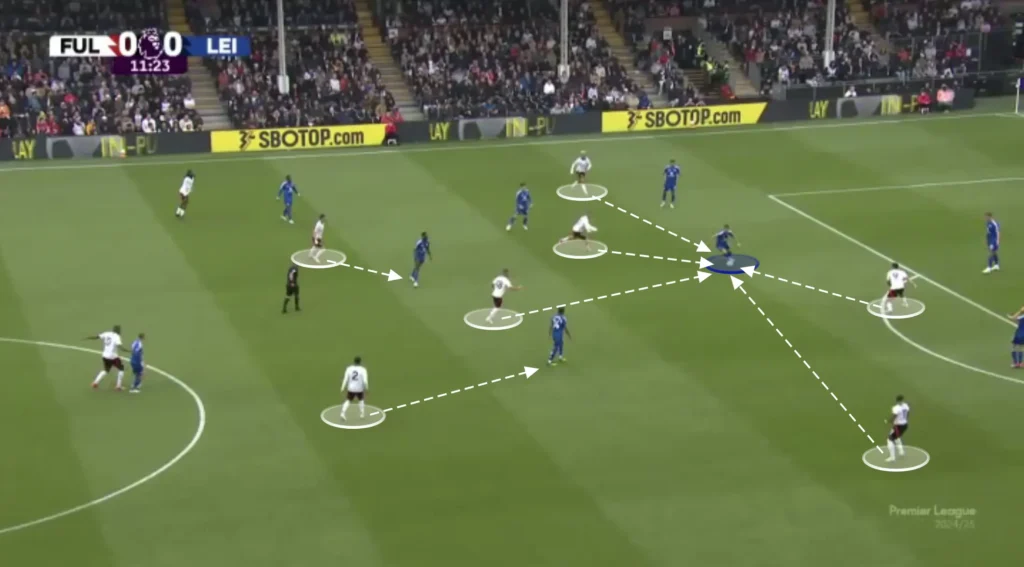
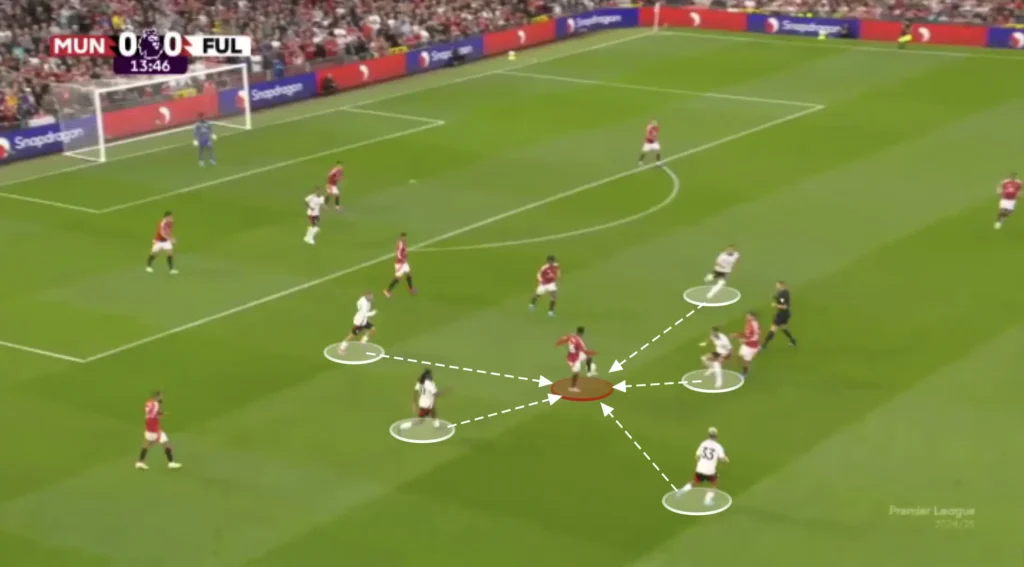
Counterpressing like this keeps Fulham on the front foot, allowing them to dominate possession and create more scoring opportunities. However, it requires exceptional fitness, tactical discipline, and teamwork.
Offensive Transitions
Marco Silva also wants his team to counterattack in their offensive transitions. When winning the ball back, the team transitions quickly from defense to attack, utilizing the speed and movement of their forward players. Silva emphasizes vertical passes to exploit spaces left by the opposition, often targeting wide areas or gaps between defenders. Fulham’s counterattacks are well-organized, with players making intelligent off-the-ball runs to create overloads and support the ball carrier. This quick, direct style catches opponents off guard, making Fulham a dangerous team on the break. Additionally, Fulham’s aggressiveness means they have many players high up when defending, which enables them to incorporate more players into the counterattacks.
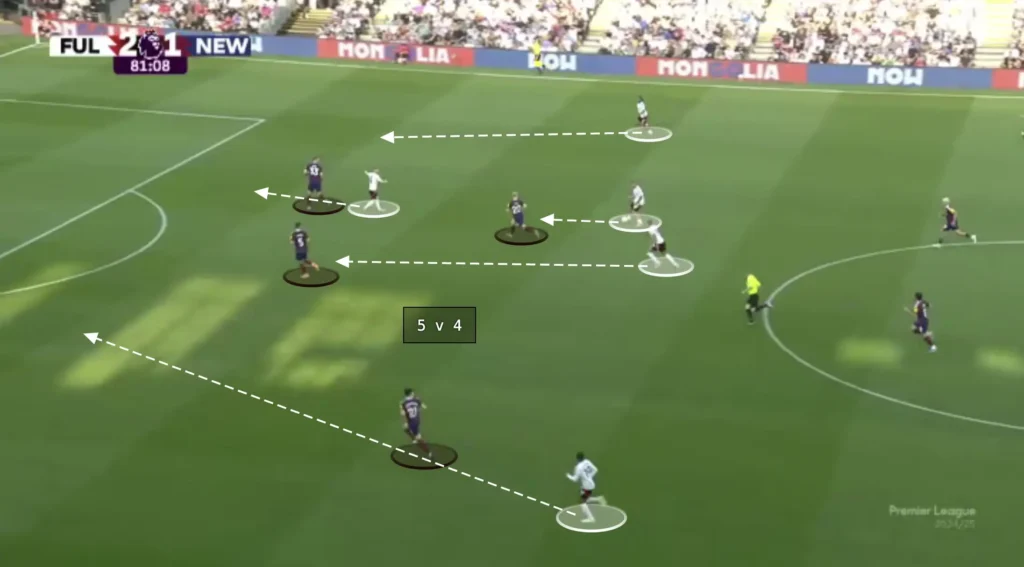
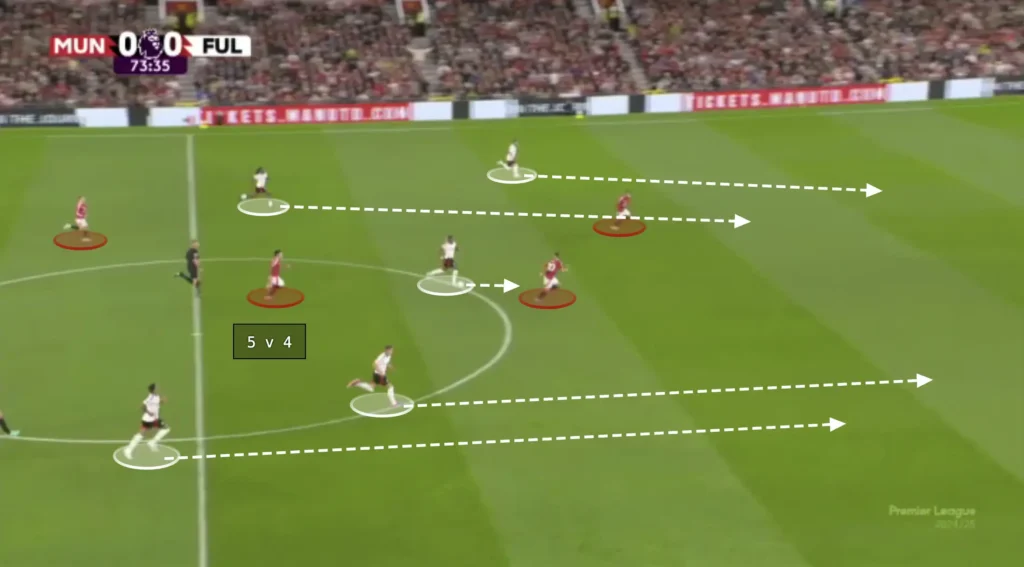
Final Thoughts
In conclusion, Marco Silva has transformed Fulham into a well-organized, tactically astute team capable of competing at the highest level. His emphasis on a balanced approach—combining defensive solidity with fluid attacking play—has brought stability and excitement to Fulham’s game. Silva’s tactical flexibility, from pressing high to absorbing pressure and breaking quickly, has made Fulham unpredictable and difficult to break down.
This tactical analysis highlights how Silva’s vision and strategies have revitalized Fulham, allowing them to perform confidently in the Premier League. As the team continues to evolve under his leadership, Fulham’s progress will be a testament to Silva’s tactical mastery.
